
Neurogenic intermittent claudication describes a set of debilitating symptoms most often associated with lumbar central spinal canal stenosis. The most common expressions of the condition include pain, cramps and spasms in the legs that come and go due to known or unknown factors. In some patients, symptoms are continually present, making the diagnosis persistent neurogenic claudication instead.
NIC can also be caused by other sources besides lumbar stenosis, although it is rarely diagnosed as such. Regional ischemia of the lumbar nerve roots is the underlying mechanism for neurogenic claudication to occur, but this oxygen deprivation does not necessarily have to originate due to structural compression. In many cases, the symptoms can be non-structurally-motivated.
This essay takes a deep and objective look into neurogenic claudication. We will examine the traditional medical stance of the disorder, as well as the more modern point of view. We will also detail the symptoms, causes and treatments for the condition.
Symptoms of Neurogenic Intermittent Claudication
Symptoms of NIC range across several possible expressions that might change in a particular patient or might remain the same, but vary from patient to patient. Painful cramping in the legs is almost universal. This pain might affect the upper rear or outer thighs, the frontal thighs, the calves, the ankles or the feet. Some patients have pain in just one area, while others suffer multiple regions of cramping and discomfort. Pain might be unilateral or bilateral. Additionally, most patients have sensations of intermittent tingling and numbness, often leading up to attacks of pain and following flare-ups of acute pain. Saddle paresthesia is a relatively common symptom in advanced cases of NIC.
Some patients demonstrate objective or subjective weakness in the leg muscles and might even display the signs of anatomical deficits like foot drop. Rarely, the patient might also suffer recurrent bouts of temporary incontinence of bladder or bowels or the experience of sexual dysfunction.
Symptoms generally come and go, often in relation to extended periods of a straightened spine, such as when standing or walking. Some patients suffer recurrent bouts of pain while reclining in bed, especially if they sleep on their back.
Causes of Neurogenic Intermittent Claudication
The most commonly diagnosed cause of neurogenic claudication is certainly lumbar spinal stenosis. Since mild to moderate stenosis is virtually universal in the older adult population, this should be no surprise. In the spinal stenosis model, the nerve roots of the cauda equina suffer from ischemia, also known as a lack of oxygen, due to structural compression. This compression can occur from many possible sources, including bulging discs, osteoarthritis, scoliosis, hyperlordosis or spondylolisthesis in the lumbar spinal region.
Other possible causes exist, but are rarely investigated in patients above middle age, since these people will almost certainly demonstrate the type of stenosis that is often implicated as the cause. This is a medical mistake of epic proportions, since many patients might have pain originating from a completely different source. Alternative possible causations include:
Local sciatic nerve injury or compression of the sciatic nerve by the piriformis muscle can create identical expressions to stenosis-related neurogenic claudication. Certain disease processes, such as diabetes, may also be contributory.
Mindbody causation also embraces the ischemia theory of symptomatic activity. However, in this psychogenic form of neuralgia, the symptoms do not come from any type of structural compression, but instead originate in the mind and directly target the spinal nerve roots, and or sciatic nerve, using reduced circulation. When blood supply is purposefully limited, ischemia will result and the symptoms can come and go at the whim of the subconscious mind. We tend to focus on this causation, since many doctors ignore it or do not even know of its existence. Dr. John Sarno discusses the many dramatic effects of psychogenic ischemia in his various works covering the tension myositis diagnosis.
Neurogenic Intermittent Claudication Treatment
Treatment for neurogenic intermittent claudication usually centers on resolving the spinal stenosis thought to be at the heart of the problem. In order to accomplish this objective, surgery is generally required. The exact procedure utilized will depend on the causative factors of the stenosis, but will most often involve one or more of the following surgical techniques: discectomy, laminectomy, foraminotomy, spinal implant placement (such as the X-Stop or Coflex), corpectomy and/or spinal fusion.
A select few cases of stenosis that is related to a pathological intervertebral disc might be able to be successfully resolved without surgery using spinal decompression. Others might be corrected using truly minimally invasive approaches to surgical care such as nucleoplasty or IDET.
Nonsurgical symptom management is also possible using a wide range of conservative therapies. Some of the most often used include chiropractic, physical therapy, massage and acupuncture. Of course, the liberal prescribing of powerful prescription drugs is virtually universal for all patients who are diagnosed with neurogenic claudication.
Simple home treatment can be accomplished and this path usually revolves around activity avoidance and the implementation of exercises that help expand the lumbar spinal canal. Simply bending forward or sitting helps many patients, while activities like swimming, yoga and tai chi might prove to be of value, as well.
Piriformis-related neuralgias should be dealt with by a specialist and can usually be resolved without surgery.
Mindbody variants of NIC must be treated using appropriate forms of knowledge therapy to root out and remove sensitive emotional instigators in the subconscious mind. We have corresponded with many patients who had been labeled with structural neurogenic claudication, but were able to completely end their pain by applying nonphysical treatments in the form of knowledge therapy.
It is vital to remember that claudication in the legs can also occur due to vascular reasons, so these possibilities should be eliminated during the early diagnostic evaluation process in order to prevent yet another chance for misdiagnosis to occur.
Back Pain > Back Pain Symptoms > Neurogenic Intermittent Claudication





